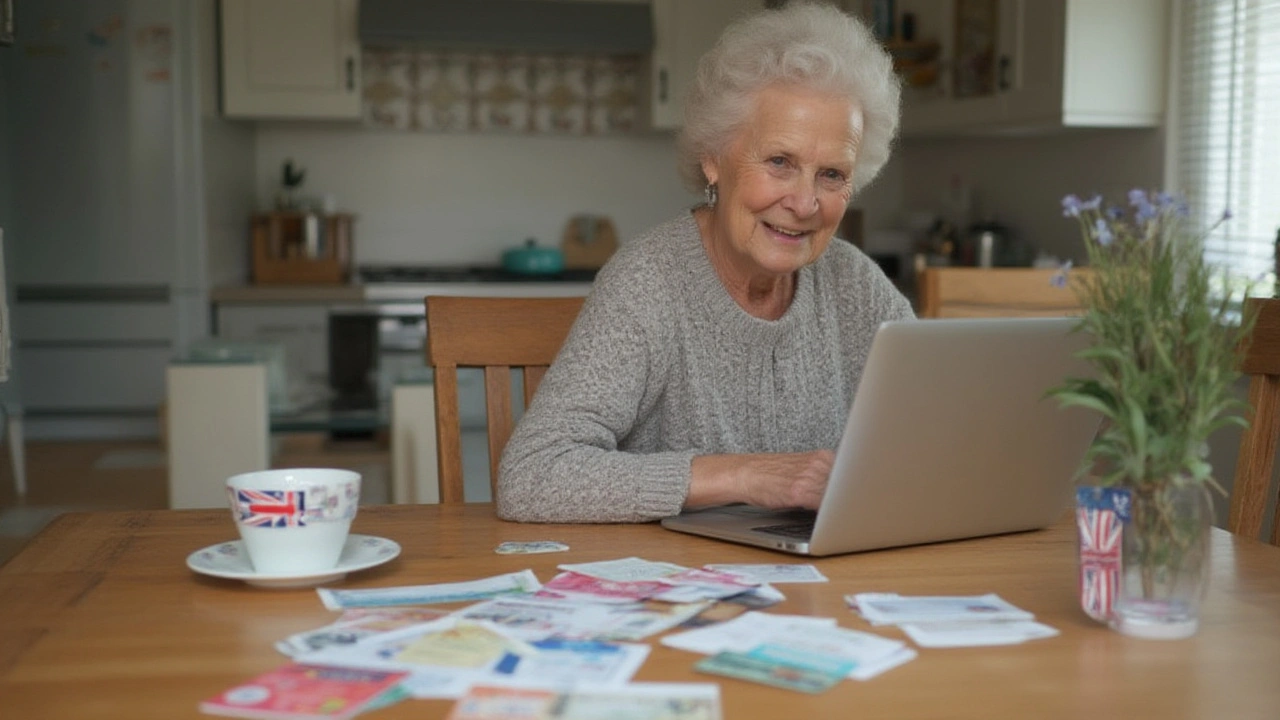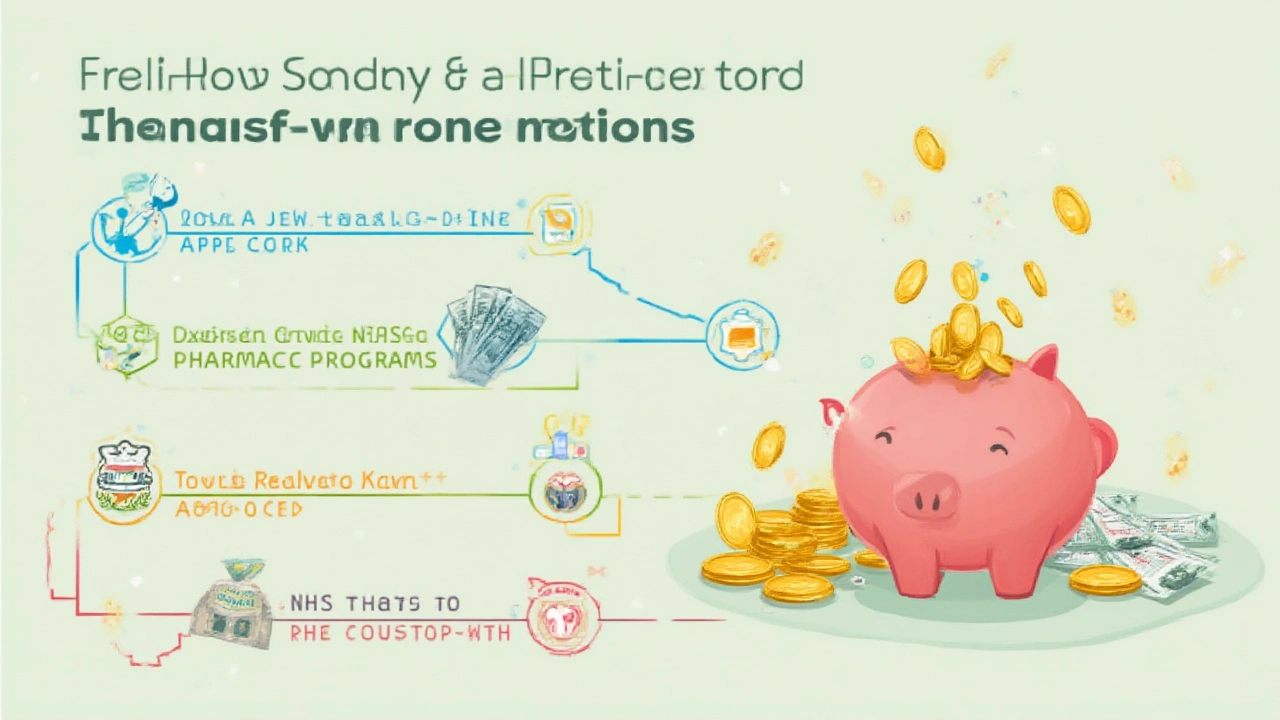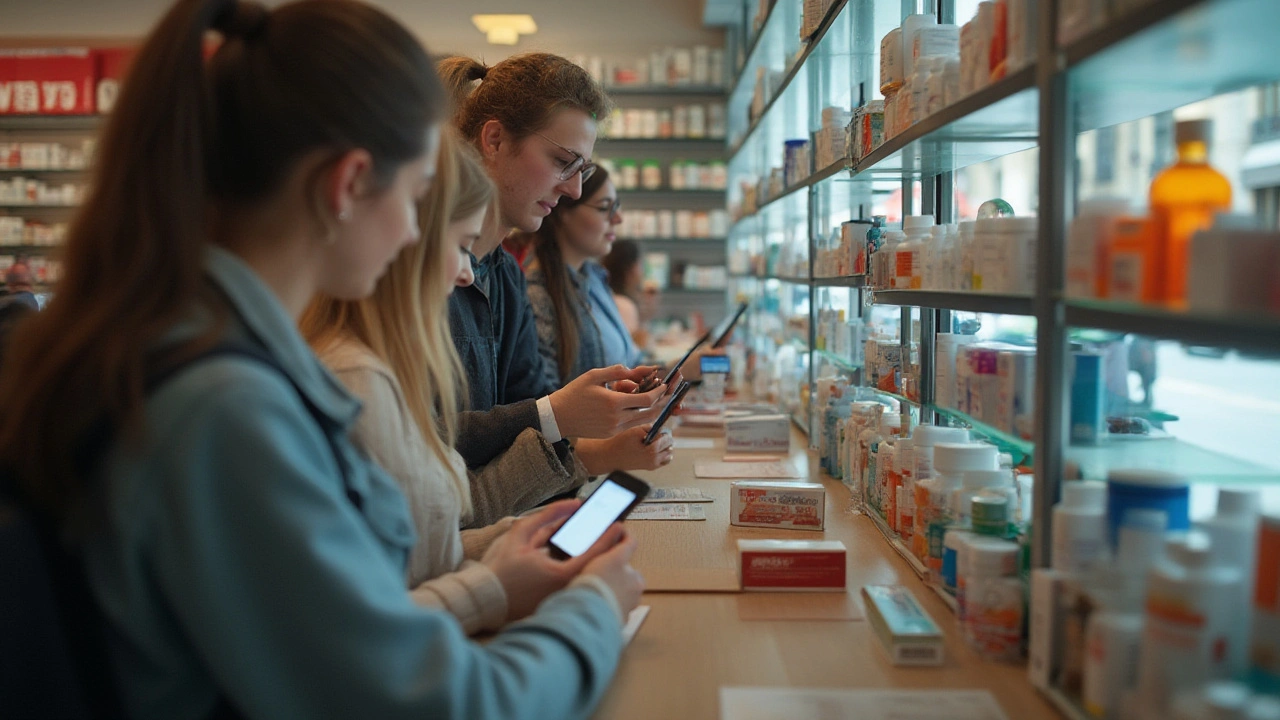Sticker shock at the pharmacy is a genuine thing, and if you’ve ever forked out a cool hundred for an asthma puffer or a handful of antibiotics, you know exactly what I mean. In the last year alone, prices for common prescription drugs have jumped by more than 7% across Australia. I’ve seen this firsthand with my son Alistair’s EpiPen refills. One you pay attention, you start spotting random price swings not just from one pharmacy to the next, but from month to month. The tools people use to whack those numbers back down? Not just GoodRx. GoodRx might be the most recognizable name in pharmacy discounts, especially in the US, but in 2025, there are a heap of solid alternatives. Some work better with local chemists. Others work brilliantly for anyone travelling or buying for family. The surprise? Plenty of Aussies are tapping into US-based cards or programs that work cross-border, and not every chemist knows about them. Even in Sydney suburbs, these tools can save you more than 50% on scripts—if you know where to look.
The Top 7 GoodRx Alternatives: What Actually Works?
Let’s dive straight into the stuff that matters: the cards, platforms, and apps that are pulling their weight this year. I went through a lot of the noise, checked forums filled with chronic illness patients, printed cards, and even pestered a few chemists around Sydney CBD and Parramatta.
- SingleCare: Tried and tested in the US, and tons of Aussies order through online American pharmacies that ship here with this discount. SingleCare doesn’t require memberships and the app is free. It covers over 10,000 drugs, and the average user saves around 45%. Some local chemists now recognize SingleCare cards quietly, even if they don’t advertise it, specially in city suburbs.
- ScriptSave WellRx: This one runs neck-and-neck with GoodRx for many drugs. Regular users report $20-$100 savings on meds like statins or blood pressure pills. The trick? Its interface lets you compare pharmacies on a map, showing real time prices, so you skip calling around. Also, it has an automatic coupon function for a handful of stores operating across both the US and Australia.
- RxSaver: This app does not require registration—just punch in the drug and see the price at major US and some global pharmacies. Its secret sauce is in exclusive coupons. Curious fact: Even some mail-in online chemists like Chemist Warehouse have honored RxSaver coupons if you flash the phone screen at the counter (especially when challenged on price matching).
- Optum Perks: Strong on everyday drugs: asthma, diabetes, antibiotics. The app itself is no fuss, just a quick code or screenshot. What makes it a stand-out? There’s a monthly max cost on dozens of common meds—never pay above the limit, no matter the pharmacy. A Hack: some independent pharmacists accept these discounts to match a major chain’s price.
- Valisure: Not exactly a discount card, but an online pharmacy with transparent prices and independent lab-testing for drug purity. You see the drug, its price, and a real analysis certificate. It’s US-based, yes, but increasingly, international buyers use Valisure to compare bulk rates and occasionally use their reports to get price matches from picky Sydney chemists.
- US Pharmacy Discount Cards (like WellCardRx and FamilyWize): These may sound ‘niche,’ but thousands in Australia order meds online with them every month. No cost, no sign up, just download and print. Benefits? Massive on generics—up to 80% off some chronic medications. Also works seamlessly for family members who travel or study overseas.
- Pharmacy Retailer Programs (Chemist Warehouse, Priceline): Let’s not forget the giants in our backyard. Chemist Warehouse’s discount program uses volume buying to drop prices sometimes below even the cards above. Shop around, use their online price-matching tool, and don’t be afraid to show them a competitor’s better offer. Priceline’s loyalty club also piles on value: free flu shots with high spending, ‘double points day’ discounts, and targeted medicine coupons sent to app users.
That’s the tip of the iceberg. There are dedicated forums and websites comparing savings in real time. Looking for recent price comparisons and more alternatives? Check out this list of GoodRx alternatives where readers drop first-hand tips and cross-region tricks all the time.

How Discount Cards and Apps Actually Slash Costs
So why can two people pay completely different prices for the exact same medication, in the same city, at the same time? It’s not magic. It comes down to the wild way pharmacy pricing agreements work, where markups and rebates can fluctuate almost by the week—especially on generic meds. GoodRx and other big-name cards essentially let you piggy-back on bulk-negotiated rates, usually reserved for insurance companies or giant pharmacy chains.
To get specific, when you show your discount card or digital coupon, the pharmacy checks it through a private network. Instead of billing as usual, they tap into a pre-negotiated price—sometimes resulting in prices even lower than your local Medicare co-pay. Sometimes pharmacists genuinely haven’t seen these cards before and will be shocked at the price. Hint: don’t be shy about showing them how it works, especially if you have a printed coupon, or you can use the app. There’s no law against a pharmacy taking a discount card—as long as they’re part of the network, or willing to honor the deal for competition’s sake. My chemist in Burwood told me his store is seeing three or four new discount card users every week now, up from just one a month last year.
| Program/App | Upfront Cost? | Max Savings Noted | Works in Australia? | Notable Feature |
|---|---|---|---|---|
| SingleCare | No | 45% | Direct / Online | Simple interface, big on generics |
| ScriptSave WellRx | No | $100 per refill | Some stores | Live pharmacy price map |
| RxSaver | No | 80% (on some meds) | Some matches local | Easy, no signup needed |
| Optum Perks | No | Flat monthly caps | Pricematch possible | Works for chronic meds |
| Valisure | No | Bulk discounts | Ships online | Lab-tested for purity |
| WellCardRx/FamilyWize | No | 80% (generics) | Order via mail/online | No membership required |
| Chemist Warehouse | No | Matches US discounts | Australia-wide | Beat-any-price policy |
It’s not just Americans who benefit. A Sydney-based survey in late 2024 found nearly 30% of chronic illness patients aged 25-45 had used a discount card, app, or pharmacy loyalty scheme for at least one prescription refill. That’s up from under 10% three years before, with growth even faster in metro Melbourne and Brisbane. Even my daughter Imogen—if she had to get antibiotics—knows to ask what the price would be with a discount before filling anything.
Now, to get the biggest bang for your buck? Stack methods. For example, check your drug’s price on multiple apps. Call three chemists with coupons from different cards. And don’t ignore pharmacy group programs—they sometimes beat even the big name apps if there’s a drug promotion running. For drugs not covered by discount cards (usually brand-new name-brand releases), your best bet might be a pharmacy’s own generic swap scheme.
If you’re feeling lost on which cards actually cover your meds, or anxious about privacy, stick to cards that don’t require full account registration or storing your scripts online. Apps like RxSaver and Optum Perks let you search anonymously. Be wary of cards or sites that ask for Medicare numbers, unless they’re a pharmacy chain’s genuine rewards scheme.

Smart Tips To Max Out Your Savings (And Watch For Sneaky Tricks)
This is where the real-life, tested tips count. I’ll share the stuff people don’t always write on message boards—but that works on the ground:
- Never assume one card or app will always be cheapest. Prices swing every week. My last refill for Alistair’s medication was $38 with SingleCare but $17 with ScriptSave WellRx.
- Show multiple offers. Some pharmacies will match a competitor’s app price or online card if you show them. Take screenshots before you leave home in case reception parts ways inside.
- Try consolidating refills. You sometimes score a ‘bulk’ price on double or triple quantity scripts, especially at Chemist Warehouse or via online pharmacies—just ask the pharmacist politely.
- Don’t forget loyalty program surprises. Priceline, for example, has “double-dip” weeks where card members get instant $10-20 cashbacks for filling certain scripts. Sign up—spam emails aside, it pays for itself after one or two fills.
- Always check expiry dates on coupons. Some pharmacist clerks miss that, and you don’t want an awkward counter chat.
- Mail-order pharmacy can save BIG. Even for Australians, ordering a 3-month supply via a reputable online international pharmacy, using a discount card, often beats buying monthly at local shops—especially for blood pressure, cholesterol, or diabetes meds.
- Ask about generic alternatives. Many app-based programs focus on generics. Doctors will often rewrite scripts for the cheaper option if you explain your savings game plan up-front.
- Don’t pay a fee upfront. If a discount card or program charges to “activate” savings, avoid it. The best-verified cards and apps are truly free to use.
- Review regularly. Pharmacy chains change their policies all the time. Make a habit to check your drug price every few months, just to be sure you aren’t missing out when a competitor updates their program.
And if you want to keep your savings game tight? Join a local Facebook group focused on pharmacy savings for your city. That’s where you hear when fresh discount cards, pop-up pharmacy deals, or rare manufacturer’s coupons drop. If you’ve got family travelling to the States, ask them to grab you some of the no-name pharmacy discount cards—they work online, and some Aussie stores will match the US price as a courtesy, especially in big city centers.
The main takeaway: don’t stick with the first price you’re quoted. New cards and apps pop up all the time, and when you combine them with shop loyalty programs and bulk ordering, you’re almost guaranteed to save $100s a year—money better spent fueling up the car for a weekend with the kids than fattening a pharmacy’s profit margin.
This is THE year to get savvy, because the price differences are only getting wider—and nobody misses burning cash on medicine when there are smarter options on the table.


Michelle Guatato
July 19, 2025 AT 06:03Have you ever wondered why discount cards keep popping up out of nowhere?
The truth is they’re part of a coordinated effort by big pharma to keep us hooked on their pricing games.
Every time you flash a SingleCare or RxSaver coupon, the pharmacy logs your ID, the drug, and the exact discount you received.
That data is fed back to the manufacturers, who use it to fine‑tune price hikes on the next batch.
In other words, the more you “save” today, the more expensive the same pill will be tomorrow.
It’s a classic price‑elasticity trap that keeps us chasing ever‑changing coupons.
The apps even use GPS spoofing to show lower prices in affluent neighborhoods, steering low‑income shoppers toward pharmacies that subsidize the data collection.
If you think that’s a conspiracy, look at the recent leaks from insider whistleblowers who proved the backend servers are hosted by the same firms that run the insurance rebate programs.
Those servers store every barcode scan and cross‑reference it with your health insurance number when you have one, building a profile of your medication habits.
That profile can be sold to data brokers for targeted advertising of “premium” brand‑name drugs.
So the discount card isn’t a free lunch; it’s a surveillance tool disguised as a penny‑pincher.
You can still use them, but do it with eyes wide open and don’t let the pharmacy chain see the whole picture.
One trick is to clear your phone’s cache after each lookup, or use a disposable burner phone for the initial search.
Another is to print the coupon on plain paper and avoid the app’s QR code, so the point‑of‑sale system can’t tag your device.
Remember, the ultimate goal of these programs is to keep us dependent on their ecosystem, not to give us genuine savings.
Stay skeptical, stay informed, and question every “free” discount you encounter.
Gabrielle Vézina
July 28, 2025 AT 12:16Wow that list is overkill
carl wadsworth
August 6, 2025 AT 18:29Everyone, the biggest win is to treat these tools as a toolbox, not a magic wand. Start by checking the price on three different apps, then call the pharmacy with the lowest number and ask if they can match or beat it. Most places will respect a straight‑forward request if you have a printed coupon handy. Don’t forget to ask about bulk‑purchase discounts; many local chemists will give you a better rate if you’re willing to pick up a 3‑month supply. And if a pharmacist seems hesitant, politely remind them that you’re a regular customer and that loyalty goes both ways. Keep a small notebook of which drugs you saved the most on – that way you’ll know exactly which apps work best for each medication. Finally, always double‑check the expiry date on any coupon before you leave the board, because an expired code can lead to an awkward checkout.
Neeraj Agarwal
August 16, 2025 AT 00:43Just a quick tip – the RxSaver app sometimes misspells the drug name in the search box, so you might have to type it a lil bit wrong (definately not ‘definitely’) to get the right results. Also, clear the cache if you see stale prices, it usually forces a fresh pull from the server.
Rose K. Young
August 25, 2025 AT 06:56I read through the whole list and most of these cards are just gimmicks. If you’re not willing to spend 10‑15 minutes comparing prices, you’ll waste money anyway. Stick to the big names – they’ve proven they work.
Christy Pogue
September 3, 2025 AT 13:09Hey folks, love seeing this roundup! 🎉 I’ve been using SingleCare for my asthma inhaler and it saved me $30 each refill. Pair it with Chemist Warehouse’s price‑match and you’ll be laughing all the way to the pharmacy. Keep sharing your wins – the community gets stronger together! 🙌
Helena Pearson
September 12, 2025 AT 19:23Think of discount cards as the modern alchemy of pharmacy economics – turning the lead of overpriced scripts into golden savings. 🌟 Each coupon is a tiny rebellion against the corporate monolith, a poetic act of defiance that whispers, “I won’t be made a slave to profit margins.” 🎭 So swipe that QR code, flash that badge, and let the savings cascade like a waterfall of emerald light. 💚
Patricia Fallbeck
September 22, 2025 AT 01:36Oh, absolutely, because the world *needs* yet another discount card to solve the problem of skyrocketing drug prices. 🙄 Let’s just hope the next one comes with a free unicorn and a side of unicorn‑sparkle because clearly, that’s what’s missing from our healthcare system.
Brett Snyder
October 1, 2025 AT 07:49All these foreign apps are just a ploy to yank money out of true American patriots. If you love your country, stick to home‑grown programs and stop feeding the overseas pharmacy profiteers.
Nidhi Jaiswal
October 10, 2025 AT 14:03The list is useful but remember: not every pharmacy honors every card. Always call ahead to confirm.
Sunil Sharma
October 19, 2025 AT 20:16Hey everyone, just a heads‑up – I tried the Optum Perks code at my local store and they accepted it after I showed the screenshot on my phone. It saved me about $12 on my blood pressure meds. Happy to help!
Leah Robinson
October 29, 2025 AT 01:29Love the energy here! 😄 I used the WellCardRx for my son’s antibiotics and got it for half price. Really feels good to save a little extra for family trips. 🌞🚗
Abhimanyu Lala
November 7, 2025 AT 07:43Discount cards work. Use them.
Richard Sucgang
November 16, 2025 AT 13:56While the conspiracy angle is entertaining, the factual inaccuracies in the earlier post are worth noting. For instance, the claim that "every time you flash a coupon the pharmacy logs your ID" is misleading – most coupons operate via a flat discount code that does not require personal identification. Additionally, the alleged "backend servers" are simply standard pharmacy benefit manager systems, not secret surveillance hubs. Clarifying these points helps keep the discussion grounded.
Russell Martin
November 25, 2025 AT 20:09Great points, Carl! Just to add, if you’re juggling multiple apps, consider using a simple spreadsheet to track the price you got from each source. It makes it easy to see which card consistently gives you the best deal for each medication, and you can update it after each refill.